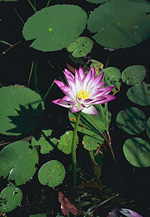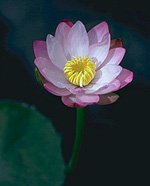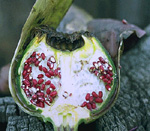 |
This is a widespread family found in most warmer regions of the world, wherever the climate is suitable for permanent waterbodies. In Australia, several native waterlilies (Nymphaea) occur in lakes and swamps in the tropical and subtropical margins of the mainland, from the Kimberley region of Western Australia to northern coastal New South Wales. A few introduced species are occasionally found naturalised in the temperate states. Ondinea, the only other genus in Australia, is restricted to the Kimberley region.
Characteristic features of the family Nymphaeaceae in Australia include: - waterlilies with large floating, round leaves (Nymphaea) or submerged linear ones (Ondinea).
- flowers showy with numerous free petals (Nymphaea) or small and lacking petals (Ondinea)
- stamens numerous
- fruit a many-seeded berry
Description
Perennial or rarely annual aquatic herbs rooted in the substrate with their leaves submerged or floating. Perennating by rhizomes. Vegetative reproduction by rhizomes. Stem nodes conspicuously swollen or not. Internal secretions not obvious or of mucilage. Plants glabrous. Leaves alternate and spiral; cauline, all or mostly basal, or both basal and cauline, petiolate, or apparently peltate. Stipules absent. Lamina simple, symmetric, lanceolate, ovate, elliptic or orbicular; base cordate or hastate or sagittate; margins entire, dentate or sinuate, ±flat; venation pinnate, or palmate, with the midrib conspicuous or inconspicuous, and the tertiary venation reticulate; surfaces not punctate; herbaceous, leathery, succulent, membranous or papery. All the flowers bisexual. Inflorescences axillary, consisting of solitary flowers. Bracts and bracteoles absent. Pollination by insects. Flowers odourless or fragrant, stalked. Perianth regular, of 2 dissimilar whorls, rarely all whorls ±similar, with 4–200 segments. Calyx segments free, with 4 sepals, imbricate, valvate or open in bud, herbaceous. Corolla segments free, with 4–200 petals, alternating with the sepals, imbricate in bud, white, yellow, red, pink, magenta, purple, violet or blue, without contrasting markings, or streaked, spotted, etc, membranous; claws absent; lobes ±entire. Fertile stamens (6–) 10–numerous, not clearly correlated with the sepals, free of the corolla, free of the ovary and style or at least partly fused with the ovary or style, distinct from each other, all ±equal. Staminal filaments sometimes distinctly flattened or rarely the filaments distinctly flattened and with embedded anther-sacs. Anthers basifixed, not versatile, opening sideways by longitudinal slits, 2-celled; appendages absent or apical. Ovary superior and sessile or part-inferior. Carpels 3–40, fused; ovary with 3–40 locules. Style single and unbranched, or absent with the stigma ±sessile and apparently terminal. Ovules numerous, stalked; placentation laminate or apparently parietal. Fruit ±fleshy, dehiscent or indehiscent; a capsule with irregular dehiscence, or a berry; the perianth on the maturing fruit deciduous, rotting or liquefying, or dry and persistent. Disseminule macro-surface featureless or with straight hairs; micro-surface ±smooth, colliculate, papillate, tuberculate, reticulate or verrucose, red, green, grey or black, dull. Seeds numerous per fruit. Aril present or absent. Cotyledons (1–) 2. Embryo straight.
(Note: this description has been generated from the coded data compiled for the key. Any errors in the key data will be reflected in the descriptions.)
A treatment of the family Nymphaeaceae has not yet been published in the Flora of Australia. It will appear in Volume 2.
Australian genera of Nymphaeaceae (as recognised for the Flora of Australia)
† = some species native, others introduced
†Nymphaea
Ondinea

|
  |

Nymphaea gigantea (flower)
Photo: G.Butler © ANBG

Nymphaea gigantea (flower)
Photo: R.Hotchkiss © ANBG

Nymphaea gigantea (section of fruit)
Photo: S.Jacobs © S.Jacobs

Nymphaea gigantea (habit)
Photo: G.Butler © ANBG

|
 |
|